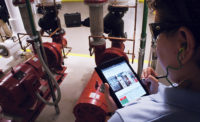
It was 9:32 p.m. when Edward, the plant supervisor, was called out to help service a malfunctioning injection molding press.
When he arrived at the 200-ton horizontal injection molding machine (HIMM), he realized almost immediately that the problem was a stuck part. He told the press operator to put the press in neutral before he opened the guarding.
As he opened the guarding, he heard the air dump, as always, which indicated that the guard was working properly. He braced his body with his left hand on the press rail as he leaned in with a tool in his right hand to free the stuck part.
Just as the part was freed, he immediately felt a strong pinch on his left hand bracing his body. For some reason the press had been activated, and his left hand was caught holding him in the equipment. He had only seconds to live. With his last breath, he screamed for help — but it was too late.
As the 200-ton hydraulic press closed in on Edwards’s upper body, the operator frantically tried to override the system and reverse the process. The system wasn’t responding because the open guarding had disabled the controls, as it was intended to do. Edward paid the ultimate price for this horrific accident. Even more unfortunate was that it was easily avoidable.
How?
A root cause analysis determined that faulty guarding controls were to blame; however, OSHA cited the manufacturer for lack of compliance with both machine guarding 1910.212 and lockout/tagout 1910.147. Root cause analysis, as some will argue, mainly focuses on one problem that needs to be fixed, when the real remedy might involve several fixes.
So what does OSHA want you to do to be safe? The answer to that question depends on your specific process and environment. Let’s first analyze this scenario to see what this employer can do to be OSHA compliant and, more importantly, prevent this accident from happening again.
Accident analysis
Injection molding machines are notoriously difficult to effectively guard because the operator must frequently interact with the moving parts of the equipment. OSHA’s regulation 1910.147 does allow for exceptions to locking out equipment if it is integral to the process and routine. But that doesn’t mean that safety can be compromised. To allow for the exception to locking the equipment out, the employer must take additional steps to ensure the alternate procedure he creates is as safe as or safer than lockout-tagout.
Here’s how the accident could have been prevented with proper compliance with both lockout-tagout and machine guarding.
Lockout-Tagout. This is meant to be the be-all, endall with safety in the workplace. If a piece of equipment is properly locked out, accidents like this will never happen. By following the equipment-specific lockout-tagout procedure (which this employer didn’t have), the equipment will be brought down to zeroenergy state in which there is no potential for equipment movement or reenergization to a magnitude that could be harmful to a person. At zero-energy state, an authorized employee can service any part of the system safely.
Machine-Guarding. When lockout-tagout isn’t practical, a company may elect to just take the energy sources out of the equation. Installing custom machine guarding will keep employees from coming in contact with energy sources during the routine operating process and minor maintenance. Machine-guarding is very effective if the employer and employees fully understand its use and, more importantly, its limitations. Even though this equipment had faulty controls (part of the electronic guarding controls) that led to the accident, proper training would have told this employee with years of experience that maintenance outside the normal operation of the equipment must use lockout-tagout. Despite this negligence, machine guarding should be designed and installed in a way to prevent unintended movement.
Even though the guarding failed, if the equipment was properly locked out, Edward would still be alive today.
Guarding vs. LOTO
What to take on first: Machine guarding or lockout-tagout? If you have the resources, taking on both simultaneously would be best. Assuming you already have a reasonable amount of machine guarding to protect passers-by from falling into the equipment, then lockout-tagout is the logical first choice. After all, even if machine guarding such as electrical light curtains, interlock switches, key off switches, etc. fail, proper use of lockout-tagout will never fail.
Start LOTO compliance
Compliance with both machine guarding and lockout-tagout isn’t always easy to achieve, but it is much easier to maintain. First, analyze your facility to determine all the equipment that needs a lockouttagout procedure. As a common benchmark for industrial facilities, the list should be relatively proportionate to the number of employees you have. For instance, if you are in a facility with 300 employees, and you think you only have 25 pieces of equipment that need a procedure, check your list again.
Quick tip: one of the eight requirements states that all equipment with more than one source of energy requires a procedure by law. Commonly missed pieces of equipment are exhaust fans (electric and kinetic), bench grinders, auxiliary equipment and tool room equipment.
Second, if you think your project is going to take more than 30 days, prioritize your list with the most serviced and most dangerous equipment first so that you can limit your exposure most effectively. Create machine-specific procedures for all the equipment to comply with OSHA’s minimum requirement in CFR 1910.147(c)(4)(ii).
Lastly, ensure your operators are trained on not just “how to,” but just as important “when to” implement a lockout-tagout procedure.
For assistance with creating effective lockout-tagout or machine guarding solutions, seek out a reputable engineering firm. Using a firm that is knowledgeable with OSHA’s safety standards and industry best practices on compliance may save you money in the long run and ensure your safety program is installed quickly and effectively.
Dealing with machine guarding and lockout-tagout is a delicate balance. With more and better machine guarding, it’s easier to reduce the number of instances that the equipment needs to be locked out. Accidents happen when employees rely on machine guarding for instances when it should be locked out. To ensure you or your employees never suffer a fate similar to Edward’s, a compliant and understood lockout-tagout program must be implemented and maintained in your facility today.
Be safe out there.

